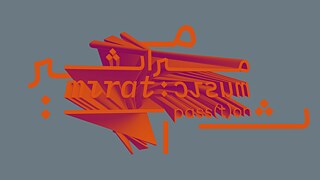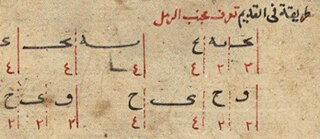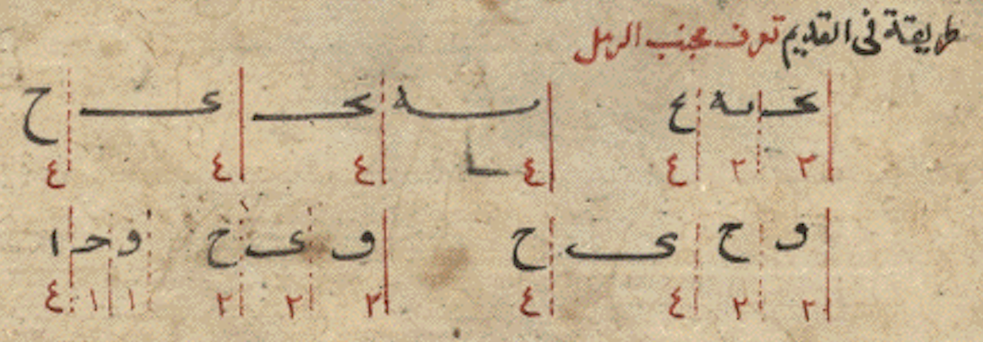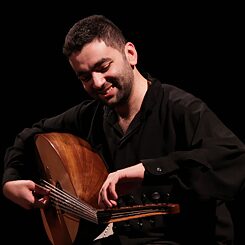Contemporary Modal Classical Music
Tariqah wa Sawt fi al Wusta طريقة وصوت في الوسطى
A wonderful connection between old classical modal music and contemporary modal classical music. Mustafa Said travels back and wanders between al-Ma'arri, Safety el-Din al-Urmawi and al-Mutanabi to solve the mystery with the secret that will remain uncovered.
In al-Adwar book by Safyy al-Din 'Abd al-Mùmin al-Baghdadi, 1294, we find some music scores documented in alphabetical notation. He documented both instrumental and vocal works. His documentations are considered the earliest clear documentation that allow someone with some knowledge in classic Arabic and poetic meters and some music theory of the Abbasi era, to easily read and perform them.
Most of these scores are very short, some of them are only four bars. If they were part of a nawbah[1] that lasts for an hour, what would such a short piece do? How would it be performed? It would be very dull if it was repeated hundreds of times. What we could read between the lines is that such form is always interpreted and reformed; it recalls the theme and variation of independent European music. The process of variating will remain a mystery, we will never be sure of the process they used mentally and musically to interpret and reform these small music phrases.
This piece and paper is a trial to play this guessing game with this secret that will remain uncovered.
Three centuries before Safyy el-Din wrote his book in the 1250s; a great poet, Ahmad Ebn Ali Ebn Sulaiman, also known as al-Mutanabbi, was writing poetry. He was, and still is, the most known poet of his age. A few decades later, Abu al-Alaa al-Ma’arri wrote the book “The Mystery of Ahmad” a critical review al-Mutanabbi's poetry. Al-Ma'arri speaks about verses of poetry that were highly esteemed by people, he mentions in his book that some of these verses were even sung by children in the streets and by the caravan camel drivers. He focuses on some verses sung by people of instruments, especially those in which the musicians created a special instrumental Tariqah introduction for them. Among these lines are the five selected below:
أبو الطيّب المتنبّي، طويل:
فَدَيْناكَ مِنْ رَبْعٍ وإنْ زِدْتَنا كَرْبا فَإِنَّكَ كُنْتَ الشَرْقَ لِلْشَمْسَ والغَرْبا
وَكَيْفَ عَرَفْنا رَسْمَ مَنْ لَمْ يَدَعْ لَنا فُؤاداً لِعِرْفانِ الرُسُومِ وَلا لُبّا
أَرَى كُلَّنا يَبْغِي الحَياةَ لِنَفْسِهِ حَرِيصاً عَلَيْها مُسْتَهاماً بِها صَبّا
فَحُبُّ الجَبانِ النَفْسَ أَوْرَدَهُ البَقا وَحُبُّ الشُجاعِ الحَرْبَ أَوْرَدَهُ الحَرْبا
وَمَنْ صَحِبَ الدّنْيا طَوِيلاً تَقَلَّبَتْ عَلَى عَيْنِهِ حَتَّى يَرَى صِدْقَها كِذْبا
Safyy el-Din documented in one of the pieces an instrumental prelude followed by a vocal piece using poetry of the same poetic metre Tawil[2] where the periodic rhythm cycle of the composition is 6, which is a part of the ramal[3] metre. He also calls this periodic cycle ramal. The rhythm of the poetic metre is 23 counts, so the unknown composer of this piece documented by Safyy el-Din divides the poetic metre 23 counts to the periodic cycle 6.
In Sawt form, Safyy el-Din documents only the basit[4] part. This part seemed to have been considered a beginning and a reference between other parts of Sawt.
This composition is an imagination of how such famous poetry, that remained famous for more than 11 centuries, with instrumental work that seemed to have been known when documented, was forgotten when the Tariqah form was replaced by other instrumental forms.
Literature and history books, however, affirm that these five verses were still being sung during Safyy el-Din’s time.
The imagination started when a musician was highly affected by the meaning of these verses. His mood was to link these verses with Wusta mode, the new music theory that some musicians call Segah[5]! The musician who isn’t bothered by the name difference, plays the Wusta or Segah and what matters to him is the music and its content. He plays the Tariqah from the end note of the mode, and from the witnesser note, which is the start of the second tetrachord.
The melody for the first half of the first line has the same topography of the Tariqah, also in the same periodic cycle, ramal. The Shatr, a half poetic line, is divided into four bars of the cycle. A fifth bar comes as an instrumental breath between the two parts of the line. These are five bars for one shatr, a line is two shatr, he chose five lines, that forms ten ashtur, ten lines. The second shatr is supposed to answer the first one and every line is supposed to be an independent unit. That means, a line should give a full meaning. Numbers mean a lot more to people of this civilisation than eight centuries ago. Thus, most of them think that numbers have inner meaning. Five bars for one shatr and he chose ten ashtur. Ten bars for a line and he chose five lines. Two divisions and two musical phrases for the Tariqah and the entire phrasing of the line is built upon the number two. question and answer, up and down, earth and heavens!
The basit of the sawt comes in the first line. He leaves the basit to the nashid[6], leaving the periodic cycle, keeping it with the instruments. He ends the nashid returning back to the cycle with his voice, also returning back to the mode after leaving it. “Who did this before?” He asks!
He should move to the tarannum, yet, he returns to the Tariqah, playing it from the same mode, then changing to sababah or dugah!
He starts a new basit in the third line from dugah, he makes a small tarannum with the vowels of the same third line, keeping the cycle as usual, however, changing the mode from sasbabah or dugah to mutlaq or mustaqim or rast[7], he does not care for names. The end of the tarannum is a long breath taking the Tariqah to be played from mustaqim.
He starts a new basit in the fourth line from rast, then ends it with a tarannum from the same mode.
He starts a new nashid, in the fifth line, leaving the periodic cycle with his voice and keeps it with the instruments. He continues in the nashid until he returns back to the cycle in the higher octave of the wusta mode. He ends with the first saihah[8], then leaves the end to the instruments, playing the Tariqah as the beginning and he continues the saihah with the instrumental end.
“Is it a new sawt? Is it more than one sawt?” He asks! Sometimes in the nawbah, they sing many aswat[9], one after the other. This is one work however! Composite Sawt then composite Sawt.
He knew about the idea of tarkib[10]. Musicians made many long rhythmic composite cycles and modes from it! “Yet a form?” He asks! “Would this last?”
He gathered his friends, playing on several types of Oud, as well as two types of Mezaf[11]
This record has been done when the world was locked in game of thrones, when a virus or a pandemic gave the best opportunity for governments to control peoples' movement, not only through borders, but at their homes, too. An authority that reminds us of the middle ages, wondering if people fully recognise that when governments take any authority, they do not peacefully or easily leave or return.
Six tracks were recorded in Cairo by the composer on six different Ouds. One of them contained also the singing.
1. Voice and Oud. This Oud is built upon the painting and description of old manuscripts of Abu el-Hassan al-Tahhan 11th century, and Safyy el-Din al-Urmawi 13th century and Abd al-Aziz Ebn Mahmoud al-Maraghi 15th century. Read and calculated by the writer of this paper and built by Albert Mansour.
2. Oud Qarar, Base Oud, known as Shahrut or Shah Oud. Built by Albert Mansour.
3. al-Abiad, Oud made by Albert Mansour, Beirut, Sebastian Stanzel, Emedengnim, Germany.
4. Sultani Oud, built by Albert Mansour.
5. Oud Nesa', Female Oud, Built by Albert Mansour.
6. Oud Jawab, Sharp or Soprano Oud, made by Albert Mansour.
Two more tracks were recorded in Beirut Performed by Ghassan Sahhab who helped in reading different copies of many manuscripts, also writing the scores in modern notation:
7. Mezaf or Jank, Made by Mohammad Ghaleb, Port Said; and Albert Mansour, Beirut.
8. Mezaf as well.
All historic and modern instruments are acoustically measured by the writer of these lines.
Hoping one day to perform in a real Music Performance.
Mustafa Said.
[1] An elaborate suite of movements that are the main form of classical Arabic music in that region. It consists of 8 to 10 sections of varying length, rhythmic character, and degree of improvisation, depending on national origin.
[2] A meter used in classical Arabic poetry.
[3] A meter used in classical Arabic poetry.
[4] A metre used in classical Arabic poetry.
[5] A musical modal system in traditional mugham music.
[6] A work of vocal music that is either sung a cappella or accompanied by percussion instruments such as the daf.
[7] A musical modal system in traditional mugham music.
[8] Getting to the high octave of the mode and it is considered the final part of the Sawt before the ending part which is supposed to be very short or even returning to the Basit.
[9] Plural of Sawt, Arabic for voice.
[10] Combining modal and rhythmic issues together.
[11] Arabic for any musical instrument.
Mustafa Said
is a musician and composer of contemporary arabic music, born in Cairo 1983. He is the founder of Asil ensemble (2003-), researcher in musicology and audio archivist. An oud virtuosoplayer and singer with Arab and international recognition. He made several concerts as a solo artist, with ensembles and collaborations. Recently he was awarded Best Musi Performance Price 2019 from the Agha Khan foundation. In addition to his research on old music manuscripts, and managing the collection of the Arab Music Archive and Research foundation (AMAR), he realized two serial podcasts specialized in Arabic music: – Rawdat al balabel – (2013 - 2017) and – with Mustafa – (2019-). Today he is working on new music projects in relation with Arabic poetry, archives, and experimenting with new playing techniques to produce new acoutstic sounds and enhance the listeners and the players experience of live music.



